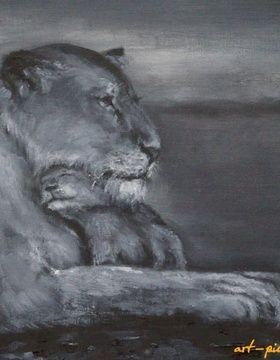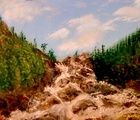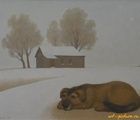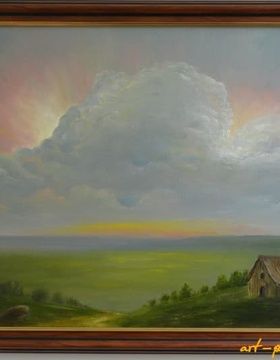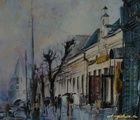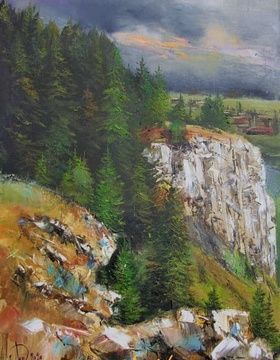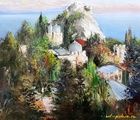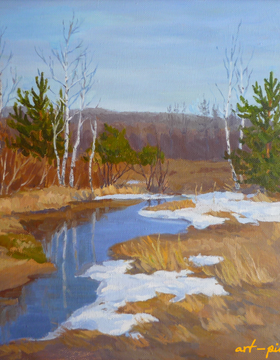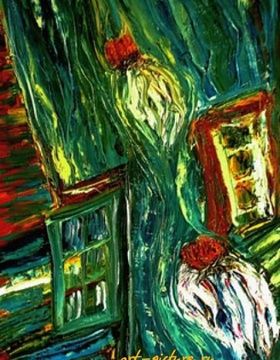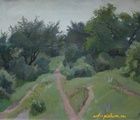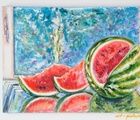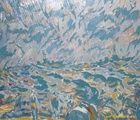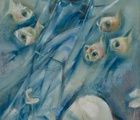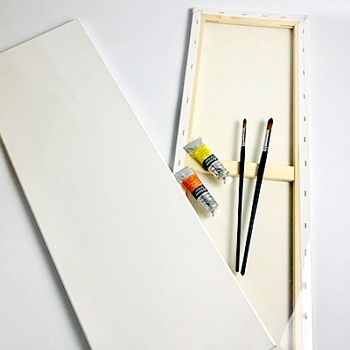
В качестве основания под живопись употребление холста известно с глубокой древности. Например, Плиний свидетельствует, что портрет Нерона, написанный одним из художников того времени (I в. н. э.) по приказу самого Нерона, был выполнен на холсте, а не на дереве, как это было принято в то время, причем длина этой картины составляла 40 м. На холсте написан и один из фаюмских портретов конца IV в. В качестве основания выбран плотный, не особенно тонкого плетения холст.
Широкое распространение в масляной живописи холст получил в Италии в конце XV – начале XVI в. Впервые холстом стали пользоваться довольно активно флорентийские и венецианские живописцы, а вслед за ними и художники северных школ – голландцы и германцы, в XVIII столетии и в России появились первые светские станковые картины, выполненные на холсте.
Большинство холстов итальянских, испанских и германских живописцев XV–XVI вв. по своей фактуре представляют собой довольно сложное переплетение крученых пеньковых или льняных ниток, выполненное ручным способом (рис. б). Многие живописцы конца XVI в. употребляли в качестве живописного холста исключительно саржевую ткань. Тинторетто, Тициан, Веронезе, многие фламандские и голландские живописцы писали исключительно на саржевых холстах. Это объясняется тем, что благодаря саржевому характеру переплетения нитей сцепление между частицами грунта и поверхностью саржевого холста значительно больше, нежели в обычном. Кроме того, все физико-механические внешние воздействия в меньшей степени сказываются на грунте, лежащем на саржевом холсте, чем на грунте, лежащем на простом холсте (рис. а).
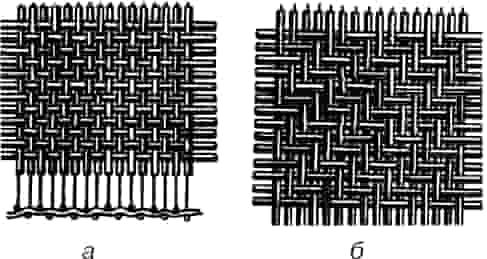
Слово «холст» не означает какую-то конкретную ткань.
Это принятое в художественной среде общее название материала из ткани, используемой для живописного основания. Холсты различаются упругостью, прочностью и способностью сохранять изначальное состояние при изменении температуры и влажности воздуха. Прочность холста обусловлена природой исходного материала, качеством, длиной и крепостью отдельных волокон, а также прядением нити, нормой и равномерностью крутки. Качество холстов зависит от структуры ткани, выделки, веса и плотности. Структура подразумевает качество и количество волокон. Ткацкое переплетение определяет выделку (фактуру). Вес холста исчисляется в граммах на квадратный метр (до грунтовки), плотность числом нитей основы и утка - на квадратный сантиметр.
Ткань в качестве основы для живописи имеет большие преимущества перед другими материалами, но обладает своими недостатками. Написанные на холсте картины легки, их можно снимать с подрамников, скатывать в рулоны, переносить и перевозить, что очень удобно, особенно при организации передвижных выставок. Недостаток холста - слабая сопротивляемость внешним механическим воздействиям: его легко продавить, проколоть, порезать. Кроме того, холст заметно реагирует на изменение температуры и влажности воздуха, так как коэффициент расширения его очень велик.
В живописи в качестве основы применяются различные ткани. Они вырабатываются из пряжи, получаемой из растительных, синтетических и комбинированных волокон. Однако не все они пригодны в качестве живописного основания. Рассмотрим технические данные негрунтованных тканей, наиболее часто используемых художниками.
Льняной холст изготавливается из пряжи, волокно которой получают из стеблей льна. Имеет сероватый и желтоватый цвет. Обладает наибольшей прочностью и стойкостью к влиянию атмосферной влаги, температурным колебаниям. Волокно льна в несравненно меньшей степени, чем другие, способно к структурным изменениям, вызываемым внешними физико-механическими воздействиями. Это позволяет льняным тканям сохранять первоначальную фактуру (зернистость), имеющую немаловажное значение для живописи. Льняные холсты в зависимости от качества нитей и выделки можно подразделить на изготовленные из пряжи длинного волокна, и из отходов первичной обработки пряжи - очёса и короткого волокна. Ткань из льняной пряжи длинного волокна имеет более ровную по толщине нить, она лучше, чем из короткого волокна и очёса, которая очень неравномерна (узлы, утолщения, утоньшения), содержит остатки растительной эпидермы (костры).
Полотно суровое (бортовка) и театральное изготавливаются из очёса и короткого волокна, выпускаются для бытового и технического применения. Они непрочны, легко деформируются. Кроме того, полотно суровое в процессе производства обрабатывается кислотой, поэтому имеет повышенную кислотность, что отрицательно сказывается на его прочности. Неравномерные нити требуют после проклейки специальной зачистки, это нарушает крепость холста, приводит к неравномерному напряжению основы проклейки и грунта. Именно в напряжённых участках на проклейке и грунте трещины возникают раньше, чем в остальной плоскости. Таким образом, грунт свободно пропускает связующее краски на оборотную сторону холста. По результатам наблюдения за сохранностью картин на этих холстах очевидно, что для живописи они непригодны. К сожалению, многие произведения наших художников написаны и пишутся именно на таких холстах. Также непригодна мешковина из грубостебельных (жёстких, лубяных) волокон: джута, кенафа и отходов первичной обработки и чесания низкомерного льна и короткого волокна.
Пеньковый холст изготавливается из пряжи, волокно которой получают из стеблей конопли. Имеет серо-белый и зеленоватый оттенок. Худшим сортом считается пряжа из волокон, слабо жёлтого или коричневого цвета. Прочность пряжи равна льняной. В настоящее время пеньковые холсты для живописи не выпускаются. Применяются только для технических нужд.
Джутовый холст изготавливается из пряжи, получаемой из стеблей джута. Имеет сильный блеск, светло-жёлтый цвет. Джутовая пряжа хрупка. Её прочность несравненно ниже, чем у пряжи из льна и конопли. Для живописных целей не рекомендуется.
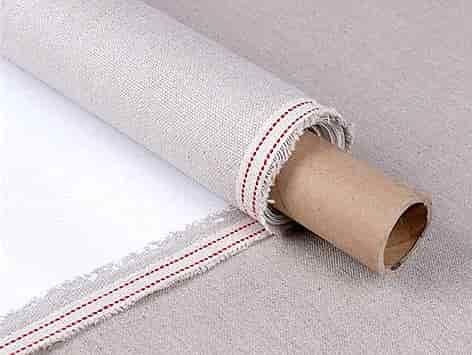
Хлопчатобумажный холст изготавливают из пряжи, получаемой из семян хлопчатника. Имеет кремово-белый цвет. По прочности значительно уступает льняным тканям. Очень гигроскопичен (поглощает влагу), подвержен гниению, в нём легко развивается плесень. Натянутый на подрамнике холст из хлопка через некоторое время провисает. Для живописных целей не рекомендуется.
Синтетический холст вырабатывается из пряжи, нить которой получают из полиэстера (вырабатывается из отходов нефтеперегона). Он прочен, весьма стоек, не подвержен гниению, не имеет тенденции к расширению и сжатию в зависимости от влажности среды. Тем не менее вопрос о применении холстов из полиэстера в качестве основы для живописи нельзя считать окончательно решённым. Этот холст не прошёл испытание временем.
Комбинированный холст наиболее распространён на рынке художественных материалов. Он вырабатывается из нитей, сочетающих растительные и химические волокна. Отечественным производством выпускаются так называемые полульняные холсты, состоящие из волокон льна и синтетических нитей. Такие холсты отличаются более светлым тоном, так как синтетические нити основы (из полиэстера или лавсана) - белые, блестящие, а льняные нити утка - серого цвета. Импортные холсты (их большинство) выпускаются в сочетании льна с хлопком, с полиэфиром, с полиэфиром и вискозой, хлопка с полиэфиром и вискозой или только с полиэфиром. Комбинированные холсты обладают различной эластичностью и устойчивостью. Каждый тип волокон по-разному поглощает влагу, изменяя при этом степень натяжения всей поверхности полотна на подрамнике. Неодинаковая гигроскопичность сырьевых материалов, а следовательно, неодинаковая адгезия с грунтом становится причиной быстрого разрушения красочного слоя. Поэтому можно поставить вопрос о рациональности использования комбинированных холстов в качестве основы для живописи.
Переплетение нитей в ткани
Полотно ткётся из пряжи двумя взаимно перпендикулярными системами - основы и утка (нити основы идут по длине ткани, нити утка - поперёк). По способу группировки перекрытий нитей различают основные типы ткацких переплетений: полотняное, саржевое, атласное; другие более сложные переплетения образуются комбинированием основных. Полотняное (гарнитуровое) переплетение представляет собой последовательно чередуемые основные и уточные нити. В ткачестве льняное плетение называется полотняным, хлопчатобумажное - миткалевым. При саржевом и атласном переплетении уточная нить проходит не под одной нитью основы, а под несколькими. Таким образом, на ткани образуются диагональные линии саржи (рубчик). При атласной кладке получается ткань, на которой с одной стороны преобладают нити либо основы (атлас), либо утка (сатин). В тканевых основаниях для живописи используются в основном полотняное и саржевое (в настоящее время не выпускается) переплетение. Другие переплетения - трикотажное, плетёное, кружевное, тюлевое - для живописных целей непригодны.
Фактура (зернистость) холста - один из основных компонентов построения живописно-красочного слоя произведения. Она определяется толщиной нитей ткани и делится на мелкозернистые, среднезернистые и крупнозернистые. Фактура негрунтованного холста одинакова с обеих сторон.
По способу ткачества холсты изготавливаются двумя нитями по основе и одной нитью по утку (полотно театральное), другие - одной, двумя, тремя или четырьмя нитями в обоих направлениях.
Основные требования к холстам
Холсты для живописи должны быть небелёными, плотными, с ровным плетением, с нитями однородной толщины (основы и утка), без узлов и других неровностей на поверхности ткани (обрывов, торчащих нитей остатков костры). Они должны обладать большой прочностью и особенной стойкостью к различным воздействиям атмосферной влаги и температурным колебаниям. Отбеливание применяется в процессе производства холста для удаления примесей и нежелательной окраски, придания белого цвета и подготовки к крашению. Наиболее широко для этого используют растворы кислот и щелочей, окислители и восстановители, что отрицательно действует на прочность холста для живописи.
Плотные ткани с частым переплетением нитей менее подвержены действию влаги, и сохранность выполненного красочного слоя несравненно выше, чем на тканях с редким переплетением. Холст саржевого переплетения более плотный, меньше разрушается при изменениях температурно-влажностного режима, так как при набухании трение между нитями саржевого переплетения меньше, чем у полотняного. Применение редких, неплотных холстов обычно приводит к возникновению в тканях сильного механического напряжения, вызывающего значительные изменения объёма (большей усадки) и приводящего довольно скоро к растрескиванию, а нередко и осыпанию красочного слоя. При неравномерной толщине нитей реакция на температуру и влажность в разных местах различна. Неравномерность вызывает нарушение связи холста с грунтом и преждевременное старение произведения. Кроме того, возникают трудности при проклеивании и грунтовании холста. Клеевая плёнка ложится неравномерно (местами проваливаясь), а нанесённый на неё грунт образует неравномерное покрытие. Эти недостатки обычно обнаруживаются при письме: «проваливается» тон из-за пожухания красочного слоя на отдельных участках (при этом первоначальный тон резко меняется). Наличие в полотнах ткацких дефектов крайне неблагоприятно влияет на зрительное восприятие картины, особенно при тонкослойном письме.
Суровые холсты, выпускаемые нашими текстильными фабриками, подвергаются специальной обработке, состоящей из следующих операций: предварительного отпаривания пряжи и ее шлихования; кислования холста, его аппретирования и каландрования.
Отпаривание пряжи – операция, при помощи которой из пряжи удаляются содержащиеся в ней соли, сахара и азотнокислые вещества.
Шлихование – операция, при которой происходит смачивание разваренным крахмалом ниток пряжи, идущих для основы ткани, – делается это для придания большей прочности ткани.
Кислование включает в себя обработку холста серной кислотой для удаления различных примесей. Оно может быть вредным, если ткань после кислования плохо промыта водой, в этом случае следы кислоты отрицательно скажутся на прочности холста и нанесенного на него грунта.
Аппретирование – эта операция улучшает внешний вид ткани путем нанесения на нее крахмала, мыла, парафина. Холст при этом утяжеляется, перегружается ненужными и лишними материалами. Каландрование – пропускание холста через вальцы специальной машины для проглаживания ткани, при котором сплющиваются утолщения ниток, узлы и другие неровности. Эта операция хоть и безвредна, но не оправдывает себя, так как при нанесении грунта эти неровности набухают и снова появляются, что затрудняет своевременное удаление узлов и должную зачистку.
Для полного удаления растворимых солей и сахара холст перед грунтовкой можно промыть в горячей воде. Кроме того, такая промывка способствует некоторому уменьшению «движения» холста при изменениях влажности воздуха.
Выбор холста
Живописцы в большинстве случаев выбирают холст по внешнему виду, без учёта его свойств и особенностей, а для живописи важно проверить, нет ли на нём ткацких дефектов, неблагоприятно влияющих на проклейку и грунтовку холста и мешающих нормальному ведению живописного процесса, а также конечному результату. Также необходимо учитывать живописные задачи, размер картины и манеру письма. Для гладкой тонкослойной живописи (в зависимости от размера) лучше всего подходят мелкозернистый или среднезернистый холст. Фактурная, пастозная живопись должна иметь более толстое и крепкое основание.
Несоответствие между манерой письма и основанием приводит к преждевременному старению произведения. Например, картина, написанная пастозно с большим наслоением красок на мелкозернистом холсте даже малого размера не сможет сдержать нагрузку и деформируется по фактуре мазков. Картина большого размера, выполненная со значительно меньшей пастозностью и также на мелкозернистом холсте, провисает под тяжестью красок.
Гладкое письмо на крупнозернистом холсте требует излишнего наслоения грунта, что недопустимо.
На среднезернистом холсте полотняного переплетения звучание красок будет иным, чем на таком же холсте саржевого переплетения. В особенности это сильно сказывается при тонкослойной живописи. Холсты с редким и грубым переплетением для живописного основания лучше не использовать, так как редкое плетение создаёт недостаточно прочную основу для красочного слоя (по нитям холста образуется мелкая сетка кракелюр), а грубый холст часто становится причиной ветшания картин.
Правильно выбранный холст во многом влияет на качество живописи, свободу и лёгкость ведения живописного процесса, сказывается на сохранности полотна и произведения в целом. А умелое использование разнообразия фактур открывает перед художником неисчерпаемые возможности их применения в целях определённого фактуропостроения живописи.
